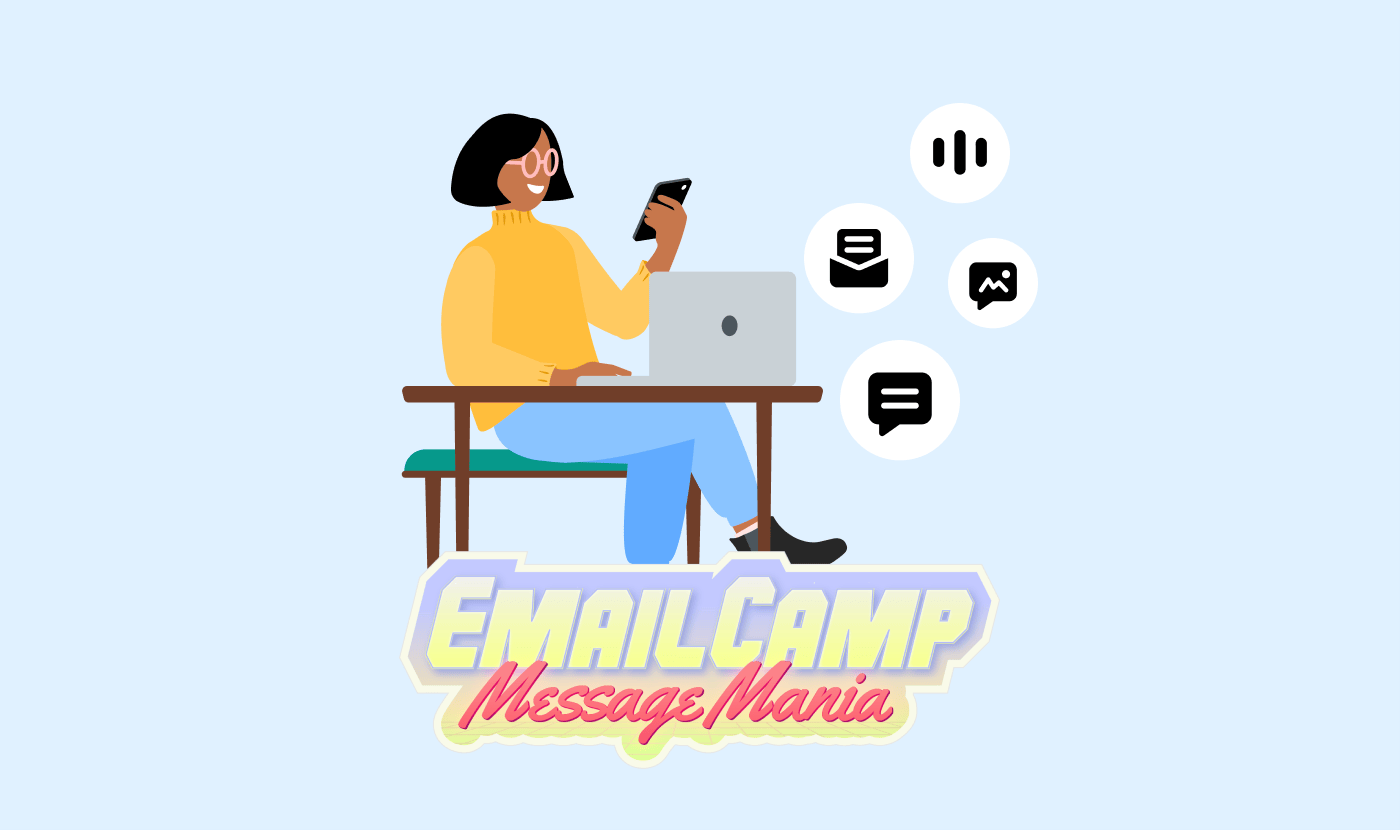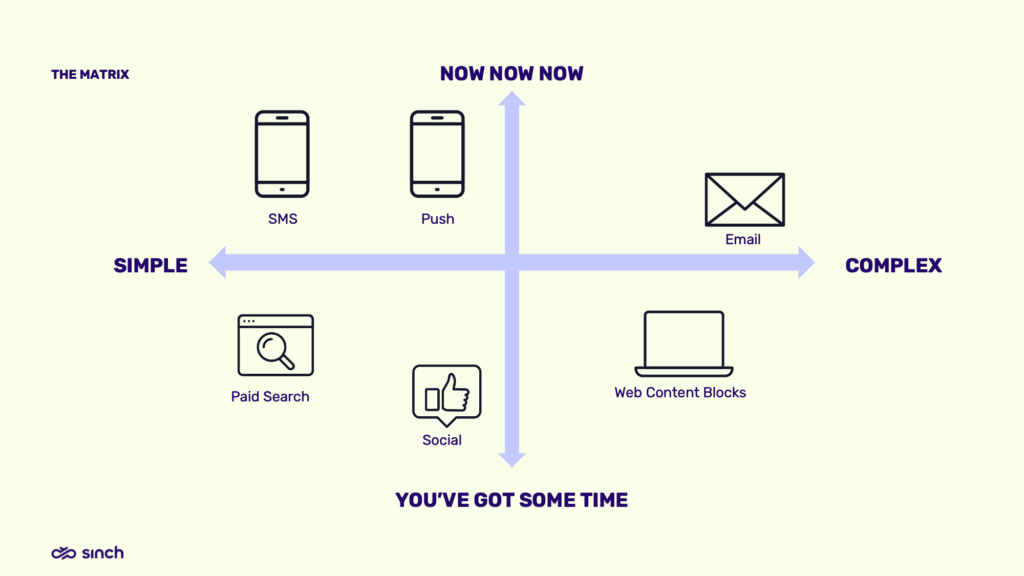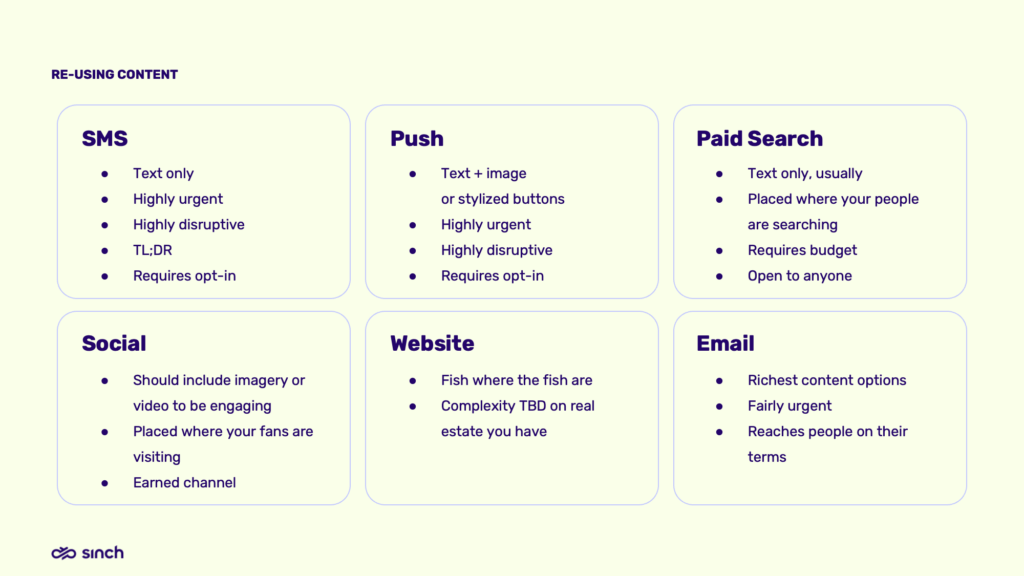Insights
Mastering multichannel campaigns: A step-by-step guide to effective messaging across channels

Insights

With so many communication channels available, how do you deliver the right message through the right channel without overwhelming your audience?
MarTech Strategist Cat Mears has a solution. Drawing from her experience bridging marketing and tech teams at Stitch, she used her session at Email Camp to introduce a practical framework that maps messages across channels based on urgency and complexity.
Her cross-channel marketing approach helps brands increase customer lifetime value by 76% through thoughtful multichannel campaigns that respect both business goals and user preferences.
Watch the full video from Email Camp 2024 as Cat Mears of Stitch shares strategies for creating effective multichannel marketing campaigns.
Let’s explore Cat’s matrix for matching messages to channels, and discover how to create coordinated campaigns that actually work.
Multichannel marketing involves connecting with customers through multiple, carefully chosen communication channels, where each plays a distinct role in delivering your message.
Marketers often get tripped up by assuming that a consistent message means identical content everywhere, but failing to tailor content per channel dilutes its impact. But instead, you should be thinking about how you can have a strategic approach to enhance your marketing communications mix.
Multichannel marketing acknowledges that different channels serve different purposes. By using each channel’s strengths, your message is better received and more likely to convert.
For example: SMS works for urgent updates, email for detailed information, and social media for ongoing engagement. Each channel has its strengths and optimal use cases.
Understanding the key differences between omnichannel vs. multichannel approaches is crucial. Omnichannel provides a seamless, consistent experience, while multichannel allows for tailored engagement per platform based on unique user preferences and platform dynamics.
The best place to start? Assess your current channels and identify their unique strengths to start seeing how you can build a more effective multichannel strategy.
Multichannel marketing starts with understanding where each message belongs. In her session, Mears introduces the messaging matrix, which can help you map content across channels using two key factors: urgency and complexity. This setup helps marketers intuitively select the most appropriate channel for each message type, ensuring both timely and suitable delivery.

The vertical axis measures urgency – how time-sensitive is your message? The horizontal axis shows complexity – how detailed does your content need to be? This creates natural groupings for different types of communications.
In the top-left quadrant, SMS and push notifications handle urgent, simple messages. For companies developing a multichannel mobile strategy, these channels are highly disruptive (think about it: They buzz in your pocket). Reserve them for time-sensitive information your audience needs to know immediately, like “Sale starts now” or “Last day to register.”
The right side of the matrix hosts complex content. Email and web content blocks give you space for detailed product information, long-form stories, or rich media. These channels work best for more involved content, as customers can engage with complex details at their own pace.
The bottom-left quadrant is for less urgent, simpler messages. Social media and paid search meet customers where they already spend time online, without demanding immediate attention. These channels allow for a ‘slow drip’ of information that builds awareness over time without demanding immediate action.
This framework prevents common mistakes like sending lengthy product descriptions via SMS or buried urgent updates in long emails. By aligning message types with channel strengths, the matrix helps you prevent common pitfalls – like sending lengthy descriptions via SMS – creating more impactful, relevant communication.
Understanding multichannel marketing starts with mapping how your customers actually move through their buying journey. Mapping your content to customer journey stages helps messages resonate by aligning with the customer’s mindset and readiness to engage.
Here’s how you can do that:
Map your customer’s journey from awareness to purchase. Mears notes, “You wouldn’t ask somebody to buy millions of dollars of software on a first date.” This ensures each message meets their needs and expectations at each stage.
“You wouldn’t ask somebody to buy millions of dollars of software on a first date.” – Cat Mears, MarTech Strategist, Email Camp 2024
The length of your sales cycle shapes your communication strategy. Retail purchases might move quickly from discovery to checkout, needing rapid-fire messaging across channels. Omnichannel banking requires an even more sophisticated approach, balancing immediate service alerts with detailed financial information and security updates. B2B sales cycles stretch longer, demanding a more nuanced approach with detailed content delivered through appropriate channels.
Start by asking three key questions:
For example, early-stage prospects might need educational content delivered through web content blocks and email, while ready-to-buy customers benefit from urgent SMS alerts about limited-time offers.
Consider both timing and context. Mears’ advice? “Map your messages against your matrix… you’ll start to see what makes sense to send to somebody based off of where they are with you.”
Major retail events show this perfectly – while many retailers struggle with their BFCM omnichannel strategy by blasting identical messages everywhere, successful omnichannel ecommerce businesses carefully sequence their communications. They might start with social media teasers, follow up with detailed email previews, send SMS alerts when sales go live, and use web notifications for cart abandonment.
This structured approach prevents common pitfalls like overwhelming new prospects with sales messages or missing opportunities to engage qualified leads.
Moving beyond the basic messaging matrix, success lies in understanding the psychological impact of each channel on your audience. Different channels create different mental states and expectations in your customers.
SMS and push notification subscribers have given you prime real estate: their phone’s notification center. For example, while Amazon might think Prime Day deserves multiple notifications, customers find early, repeated alerts annoying rather than helpful. Respect this access by sending only truly time-sensitive updates.
Email subscribers expect value, not urgency. They’ve invited you into their inbox for substantive content – detailed product information, engaging stories, or helpful resources. Meet this expectation with well-crafted, comprehensive messages.
Social media followers want content that matches platform behavior. Mears explains, “If I’m on TikTok, I don’t really want to see ads related to what I do during the day. I just want to be entertained.”
Read the room. Each channel has its own social contract with users. Honor these unwritten rules by adapting not just your message format, but your entire communication approach to match channel-specific user mindsets. When you respect the inherent expectations of each channel, you build trust with your audience, leading to better engagement and brand loyalty.
Let’s examine the core practices that turn scattered communications into strategic multichannel campaigns that respect both your goals and your customers’ attention.
Every multichannel marketing strategy needs both outbound (push) and inbound (pull) messaging to create a natural rhythm of communication.
Push messages, like SMS for flash sales, deliver time-sensitive alerts. Pull messages, like blog posts and social media, attract audiences when they’re already looking for information.
The sweet spot lies in combining both approaches. Use push messaging for truly urgent updates while maintaining an active presence in pull channels. This creates a communication ecosystem where customers feel informed but not overwhelmed.
Each communication channel has its sweet spot in the customer journey. The key is using each channel’s strengths rather than pushing every message through all of them.
At the awareness stage, social media and paid search excel at meeting customers where they are. Mears notes, “Lean into what’s popular within those particular platforms.” For example, create engaging video content for TikTok or snappy, direct messages for paid search where users want immediate answers.
For nurturing relationships, email and web content carry the weight of detailed information. These channels give you space to educate, showcase products, and build trust through comprehensive content. They let customers engage at their own pace and digest complex information.
When it’s time for urgent action – like sales, limited-time offers, or appointment reminders – SMS and push notifications take center stage. Just use these sparingly.
The most successful campaigns match content format to channel strengths. Brief, time-sensitive messages go to SMS. Detailed product launches deserve email. Educational content lives on your website. Brand building happens on social media.
Looking for more expert messaging insights from Email Camp 2024? Check out our blog about combining email and SMS strategies effectively in 2025.
Multichannel marketing requires continuous refinement based on how your audience engages across different channels.
Test basic message delivery patterns. Send an email alone, then try that same message supported by push notifications or omnichannel personalization. Monitor how engagement changes when you coordinate multiple channels versus using them in isolation.
Pay attention to channel-specific behaviors. Social media might drive awareness but convert poorly, while SMS could show lower engagement but higher conversion rates. Use these insights to adjust your channel mix and message timing.
Mears highlighted a practical approach during the session. “Test sending that same email, plus maybe a push message or plus maybe a personalized web content block or both,” she said. “Test also maybe putting that post out on social and see where people are engaging.”

Want to know if you’re overwhelming customers? Watch your opt-out rates across channels. High unsubscribe rates might signal too frequent communication or poor channel-message fit.
Mears used the example of how dating app Hinge boosted engagement with their daily match notifications. Because first, they faced a common multichannel challenge: how to deliver the right message through the right channel at the right time.
Their initial strategy relied solely on emails notifying users about new matches. While functional, this single-channel approach wasn’t generating the engagement they wanted. The solution? A coordinated multichannel strategy that respected both urgency and complexity.
Hinge redesigned their approach around three key touchpoints:
The results showed the impact of choosing the right channels. By testing different approaches, they discovered that showing actual match photos in emails (rather than blurred images) tripled click-through rates. This improvement showed that email works well for complex, visual content.
The coordinated push notifications and in-app messages created multiple touchpoints without overwhelming users. Each channel played its natural role: push for immediacy, email for detail, and in-app for engagement.
This success story shows how matching message format to channel strengths can dramatically improve campaign performance.
Executing multichannel campaigns manually isn’t sustainable as your business grows. You need the right technology stack to accomplish what you want to do at scale.
Sometimes the tools are already there but not optimized. Other times, new investments are needed. The key is identifying where technology can remove bottlenecks in your multichannel strategy.
Before adding new tools, audit your current capabilities:
Mears highlights a common challenge: marketers saying, “I just spent three weeks getting my content approved and written for this email, and now you’re telling me you want me to create banner ads and paid search campaigns and website content and social posts.”
When evaluating new technology, prioritize platforms that:
Technology should make multichannel marketing more manageable, not more complicated. Choose tools that simplify coordination while providing the insights you need to improve performance.
Modern consumers engage across multiple channels, and managing these touchpoints effectively requires a strategic partner. Sinch helps brands create coordinated, impactful multichannel campaigns.
Consider EasyPark Group’s experience. Rather than juggling multiple vendors for SMS parking reminders and one-time passcodes across markets, they consolidated their messaging with a single, reliable partner.
The result? A streamlined communication system that automatically upgrades SMS to RCS when possible, enhancing customer experience without adding complexity.
Sinch can help you execute the messaging matrix framework by:
Or, if you’re ready to start building your multichannel campaign strategy, we can help make it easy. Reach out to us today to learn how!